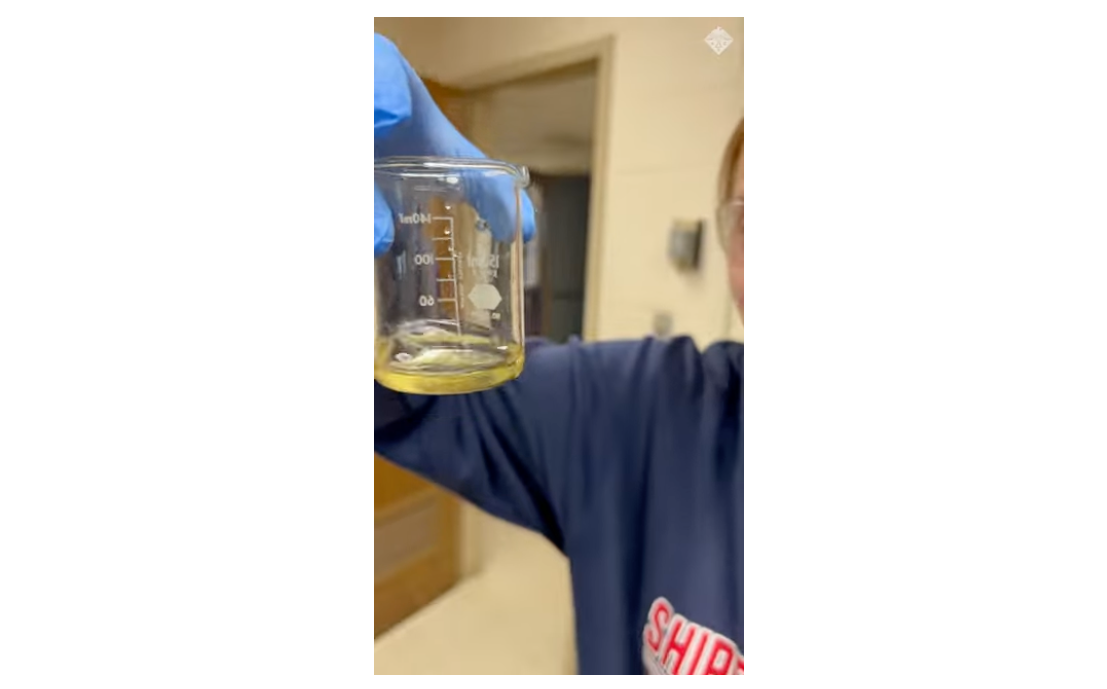From edible bugs to exercise in pill form, we bring you a roundup of hot topics and breakthrough chemistry research presented at ACS Spring 2024.

The spring meeting of the American Chemical Society (ACS), held virtually and in person March 17-21, 2024, features more than 12,000 presentations on a diverse range of science topics. Read on to discover some of the hot topics and research highlights* presented at the meeting—and check back throughout the week for more updates!
1. Seasonal Secrets Unveiled: How Wild Animals' Hair Changes to Beat the Cold
Learn how wild animals have evolved to survive extreme temperatures in the groundbreaking research led by Taylor Millett at Utah Tech University. This study explores the fascinating world of animal hair, revealing for the first time that the inner structure of animals' coats undergoes significant changes with the seasons. Unlike common beliefs that only the color of the hair changes, Millett's research shows microscopic alterations within the hair that are crucial for survival in different weather conditions.
Millett and her colleagues explored the complex hair structures of wild, big-game animals including the pronghorn antelope, mule deer, and Rocky Mountain elk. Using advanced scanning electron microscopy, they discovered the unique 'honeycomb' structure within the hairs, which changes in density and size between seasons to provide essential insulation. Their findings not only shed light on nature's ingenious ways of protecting these animals but also suggest possibilities for other applications, such as synthetic insulation for homes and consumer products.
2. Bugging Out: The Surprisingly Tasty World of Edible Ants
When it comes to keeping with ACS Spring 2024's theme of "Many Flavors of Chemistry," Changqi Liu and his colleagues understood the assignment. Their latest research uncovers the diverse and rich flavor profiles of edible ants, diving deep into the unique aroma profiles of four distinct ant species. From the acidic and vinegary taste of common black ants to the nutty and woody nuances of chicatana ants, their findings reveal that each species brings its own unique set of tastes and smells to the table, advancing our understanding of these insects' culinary potential.
The study also touches on the potential for incorporating these flavors into new food products, particularly as the world seeks more sustainable and eco-friendly protein alternatives.
Watch the Headline Science video surrounding this research, created by the ACS Science Communications team:
Explore More Bug Science on ACS Axial
Worm Slime: The Key to More Eco-Friendly Plastics?
The Secret of Spinning
A Bug’s Eye View of Road Safety
3. A Chemist's Guide to Brewing Perfect Kombucha
A team of chemists at Shippensburg University are revolutionizing kombucha brewing, tackling the challenges of inconsistent alcohol levels and flavor profiles in the fermented beverage. Their research reports on innovative ways to control alcohol content, enhance taste, and speed up fermentation, offering new insights for both home and commercial kombucha producers.
First, the team analyzed the fermentation process in different containers, where silicone bags showed superior performance over glass jars in both fermentation speed and increased acid production. They also looked into how different sugars affect kombucha's taste and alcohol content. Using glucose as a starter resulted in higher gluconic acid and lower ethanol levels, while fructose led to sweeter brews with more acetic acid and ethanol. These findings are crucial for brewers aiming to tailor their kombucha to specific flavor profiles and alcohol content.
This is not the team's first foray into the art and science of kombucha brewing. In 2023, they published a study in the Journal of Chemical Education exploring the use of a cost-effective sensor to accurately measure alcohol concentrations in kombucha across a variety of undergraduate chem lab courses. Read the article here.
Watch the Headline Science short surrounding this research, created by the ACS Science Communications team:
Read More Booze & Beverage Chemistry on Axial:
What Gives Red Bordeaux Wine a “Meaty” Aroma?
Beyond the Bean: The Science Behind Lab-Grown Coffee
Staying Fresh: The Chemistry of Beer Packaging
Like a Fine (Sparkling) Wine: How to Age Champagne Without Losing the Bubbles
4. A New Decking Material That Fights Global Warming
In a major stride towards environmentally sustainable construction, David Heldebrant and his team have developed a new composite decking material that is both cheaper than standard options and carbon-negative. It's designed to store more carbon dioxide (CO2) than its manufacturing process emits, providing a viable solution to one of the construction sector's most significant challenges: high carbon emissions.
The new material incorporates low-quality brown coal and lignin as fillers, which are then treated with CO2. Not only does this composite meet international building codes for decking materials in terms of strength and durability, but it also offers a significant cost advantage, being 18% cheaper than its conventional counterparts.
This type of composite decking could play a pivotal role in reducing the carbon footprint of the building industry: replacing all U.S. decking with this material could sequester the CO2 equivalent of the annual emissions from 54,000 cars. As the team works towards commercialization, this carbon-negative decking presents a hopeful glimpse into a more sustainable solution for the construction industry.
Read more of David Hildebrant's research on CO2 capture published in ACS journals:
Water-Lean Solvents for Post-Combustion CO2 Capture: Fundamentals, Uncertainties, Opportunities, and Outlook
David J. Heldebrant*Orcid, Phillip K. KoechOrcid, Vassiliki-Alexandra GlezakouOrcid, Roger RousseauOrcid, Deepika Malhotra, and David C. Cantu
DOI: 10.1021/acs.chemrev.6b00768
In Situ Raman Methodology for Online Analysis of CO2 and H2O Loadings in a Water-Lean Solvent for CO2 Capture
Amanda M. Lines, Dushyant Barpaga*, Richard F. Zheng, James R. Collett, David J. Heldebrant, and Samuel A. Bryan*
DOI: 10.1021/acs.analchem.3c02281
Directed Hydrogen Bond Placement: Low Viscosity Amine Solvents for CO2 Capture
Deepika Malhotra, David C. Cantu, Phillip K. Koech*, David J. Heldebrant, Abhijeet Karkamkar, Feng Zheng, Mark D. Bearden, Roger Rousseau, and Vassiliki-Alexandra Glezakou*
DOI: 10.1021/acssuschemeng.8b05481
5. A Pill to Replace the Gym?
While this may seem too good to be true, researchers have recently identified new compounds that can mimic the physical benefits of exercise—a significant advancement particularly for those unable to engage in regular physical activity.
The team, led by Bahaa Elgendy at Washington University School of Medicine, initially developed SLU-PP-332, a compound that activates estrogen-related receptors (ERRs), which are crucial in muscle adaptation to exercise. While SLU-PP-332 was a pioneering discovery, it had its limitations—particularly in its inability to cross into the brain.
To improve upon SLU-PP-332, the team engineered new molecules that not only demonstrated a stronger activation of the ERRs but also exhibited attributes like enhanced stability and lower toxicity potential. Their effectiveness was measured through an increase in RNA presence in rat heart muscle cells, suggesting a more robust simulation of exercise effects compared to SLU-PP-332.
A crucial advancement with the new compounds is their ability to penetrate the brain, opening possibilities for treating neurodegenerative disorders like Alzheimer's disease. Elgendy and his team hope to further test these compounds in animal models, potentially leading to new treatments for various medical conditions where exercise-mimicking drugs could be beneficial.
Read more of Bahaa Elgendy's research published in ACS journals:
Synthetic ERRα/β/γ Agonist Induces an ERRα-Dependent Acute Aerobic Exercise Response and Enhances Exercise Capacity
Cyrielle Billon, Sadichha Sitaula, Subhashis Banerjee, Ryan Welch, Bahaa Elgendy, Lamees Hegazy, Tae Gyu Oh, Melissa Kazantzis, Arindam Chatterjee, John Chrivia, Matthew E. Hayes, Weiyi Xu, Angelica Hamilton, Janice M. Huss, Lilei Zhang, John K. Walker, Michael Downes, Ronald M. Evans, and Thomas P. Burris*
DOI: 10.1021/acschembio.2c00720
Synthesis of 3-Aminoquinazolinones via a SnCl2-Mediated ANRORC-like Reductive Rearrangement of 1,3,4-Oxadiazoles
Mohamed Elagawany, Lingaiah Maram, and Bahaa Elgendy*
DOI: 10.1021/acs.joc.3c01973
Recent Advances in the Medicinal Chemistry of Farnesoid X Receptor
Yuanying Fang, Lamees Hegazy, Brian N. Finck, and Bahaa Elgendy*
DOI: 10.1021/acs.jmedchem.1c01017
6. Revolutionizing Cancer Research with Artificial Mucus
Led by Jessica Kramer at the University of Utah, this study marks a significant advancement in understanding the role of mucus in tumor formation. By synthesizing mucins, the sugar-coated proteins that mucus primarily consists of, the team discovered that altering the mucins in healthy cells to resemble those in cancer cells can induce cancer-like behaviors in these cells.
Kramer's approach, involving synthetic chemistry and bacterial enzymes, allows for the precise alteration of mucins and reveals how specific changes in their sugar or protein sequences can impact cellular behavior. This methodology led to the observation that healthy epithelial cells with modified, cancer-like mucins cease normal cell extrusion and begin to pile up, a process resembling early tumor formation. While it's still unclear if these cells transform into cancer cells, the findings open new avenues for developing cancer treatments targeting mucins, particularly the sugar groups on these molecules. Beyond cancer, this research could lead to the development of anti-infectives, probiotics, and other health-supporting therapies.
Watch the Headline Science video surrounding this research, created by the ACS Science Communications team:
*Press Release content and videos in this post are brought to you by the ACS Science Communications team. Learn more below.


